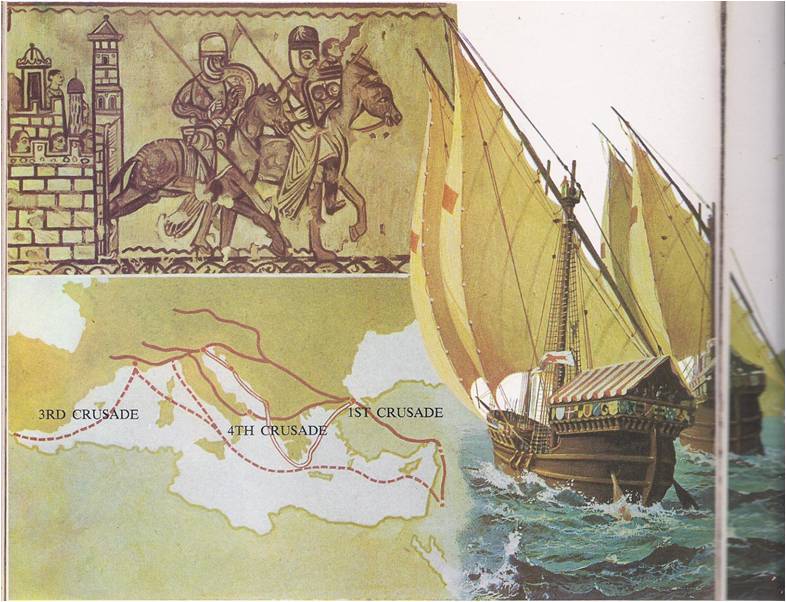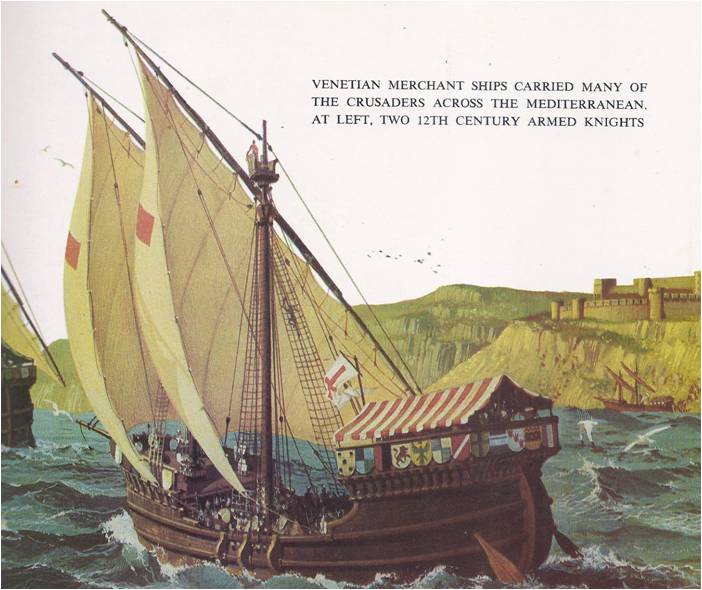THE LONG struggle between the churches of the East and the West was only one of the many serious problems that weakened the empire and led to its downfall.
Trade was another of its problems. Much of goods imported from the eastern world was sold to the west through Byzantine markets.
A ten percent tax was collected on an imports and exports as well as on all goods passing through the Bosporus. This was one of the empire’s most important ways of collecting taxes. However, this rich flow of tax money began to get smaller and smaller in the tenth century after Basil II gave Venice, the chief port of the west, a reduced tax rate. He did it with the understanding that the large fleet of Venetian merchant ships would police the Adriatic Sea and carry troops for the empire whenever necessary.
Then, in the eleventh century, the empire lost Asia Minor to Turks of the Seljuk tribe. Asia Minor was the backbone of the empire. It had served as a buffer state against invaders from the east and had provided food and materials for the empire, as well as manpower for the army. It was a serious loss from which the empire never recovered.

In the twelfth century, Thebes and Corinth fell to Norman invaders. They carried off the silkworms and weavers to Italy, thus breaking the empire’s monopoly on Silk. Byzantium also suffered at the hands of the crusaders, who conquered a part of Asia Minor from the Turks as they passed through on their way to Palestine. Instead of returning this territory to the empire, they divided it and made independent kingdoms out of Antioch and Edessa. From then on, much of the eastern trade passed through these cities and was carried to the West on Italian ships, thus escaping the heavy taxes of the empire.
COLLAPSE OF AN EMPIRE
As trade fell off, the money of Byzantium began to lose value, although Constantinople still held its position as the world’s greatest producer of luxury items. The empire had very few ships left and could not protect its own sea trade from pirates. The emperors turned to the merchant fleets of Venice, Pisa and Genoa for help, giving them in return special trade advantages. These cities were allowed to establish trading centers in Constantinople and by 1180 there were 60,000 Italians living in Constantinople. These Italian traders took much business away from the Byzantine traders and grew rich. The local people hated them and finally killed many of them in an uprising. The people of Venice were shocked and searched for a way to strike back. For many years they had wanted to get their hands on the great treasures of Byzantium and the Fourth Crusade gave them the opportunity they were looking for.

The Venetians tempted the crusaders with promises of rich booty if they would march against Constantinople. The crusaders belonged to the Catholic church of Rome, headed by the pope and they looked upon the Orthodox Christians of Byzantium as heretics who spread false teachings about the faith. They felt the Byzantines deserved to die because they were enemies of the true faith.
So the crusaders marched against Constantinople, taking it by surprise in 1204. The victorious Christian soldiers swarmed through the city, destroying and looting and killing without mercy. Many of the city’s priceless treasures, collected over a period of nine centuries, were melted down into coins. Ancient books and records were destroyed. Holy relics and much booty were carried back to Europe. The victors then attempted to establish a Latin empire with Constantinople as the capital.

When the crusaders withdrew, the Byzantines still held control of a part of the empire. This they divided into three local states at Epirus, Trebizond and Nicaea. After more than half a century‚ the Byzantines were able to recapture Constantinople under the leadership of Michael Palaeologus. He founded the last of Byzantium’s ruling families, which was to rule over the shrunken empire for almost two hundred years. The empire was no longer a world power. Parts of Constantinople lay in ruins. There was no money with which to rebuild it, or to defend what little was left of the empire.
Byzantium was spared for a time by the collapse of the Seljuk Turks, after the Mongol invasion. Later, the empire faced the rising might of the Ottoman Turks links, who belonged to the Osman tribe. As the Turks increased in strength, they began to carve off pieces of the empire for themselves. They kept at it until all that remained was the walled city of Constantinople.

Then the Ottoman Turks attacked the city itself. The end came after the people of Constantinople had made a heroic stand for seven weeks. There were very few soldiers left. Everyone in the city who could fight took his turn on the city wall. On the final night, Constantine XI and his loyal followers spent hours of prayer in the Hagia Sophia. The people joined him in a religious procession through the streets, singing, “0 Lord, have mercy on us.” The next morning, on May 29, 1453, the last of the emperors joined the people defending the broken wall and there he met death with a sword in his hand. The mighty empire of the Byzantines came to an end.
It had stood as a beacon light of civilization and culture for eleven centuries. During most of this period, Byzantine money had provided the world markets with a sound medium of exchange. The empire had spread Christianity to pagan nations of the East. In the field of art it gave the world new techniques and styles of expression. Perhaps its greatest contribution was in having protected Europe for many centuries against attacks of the great eastern hordes.





